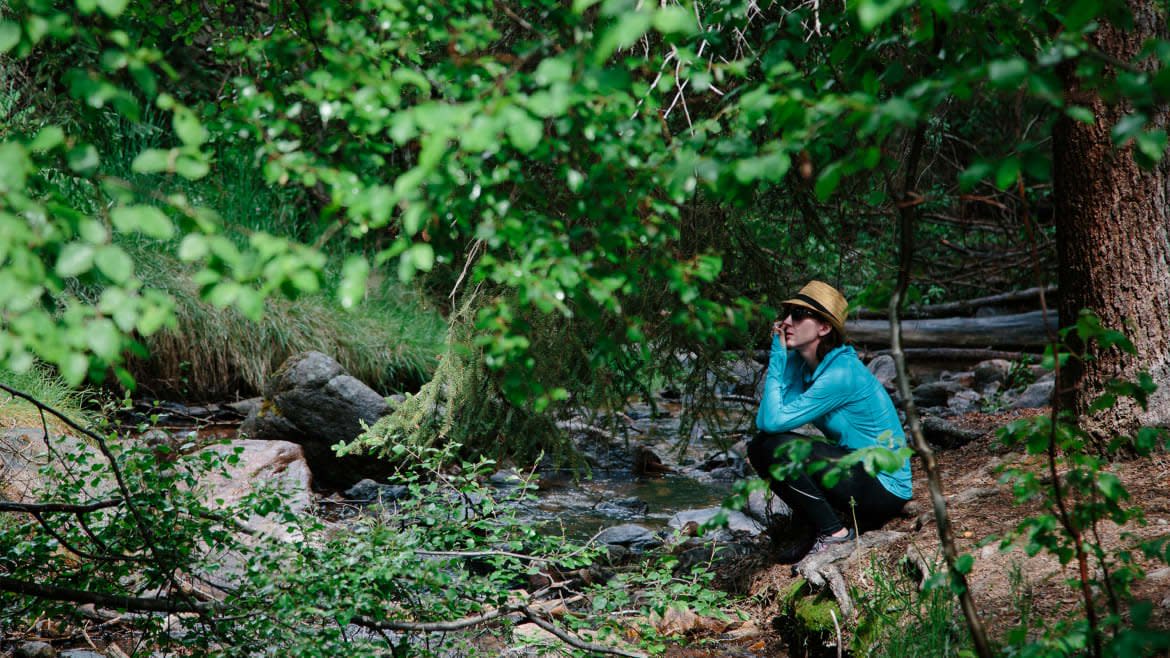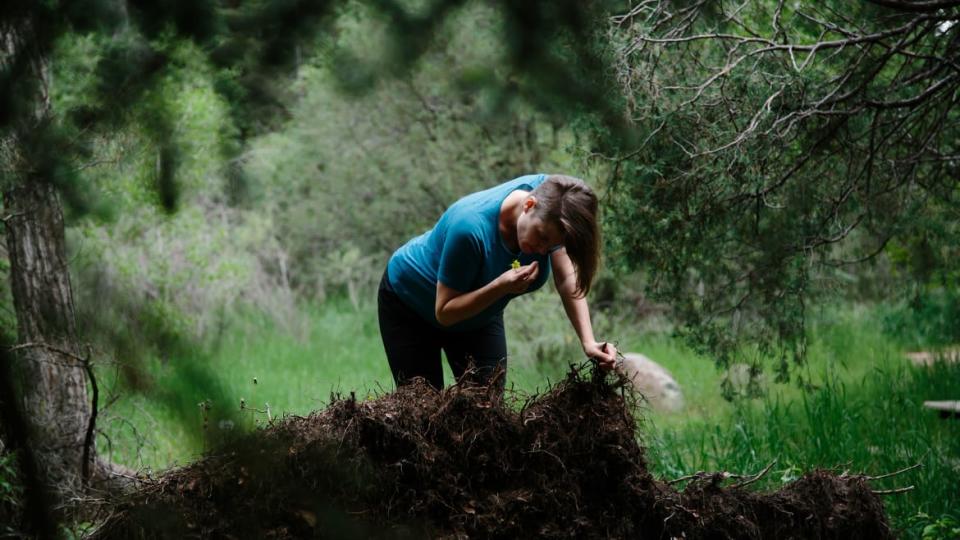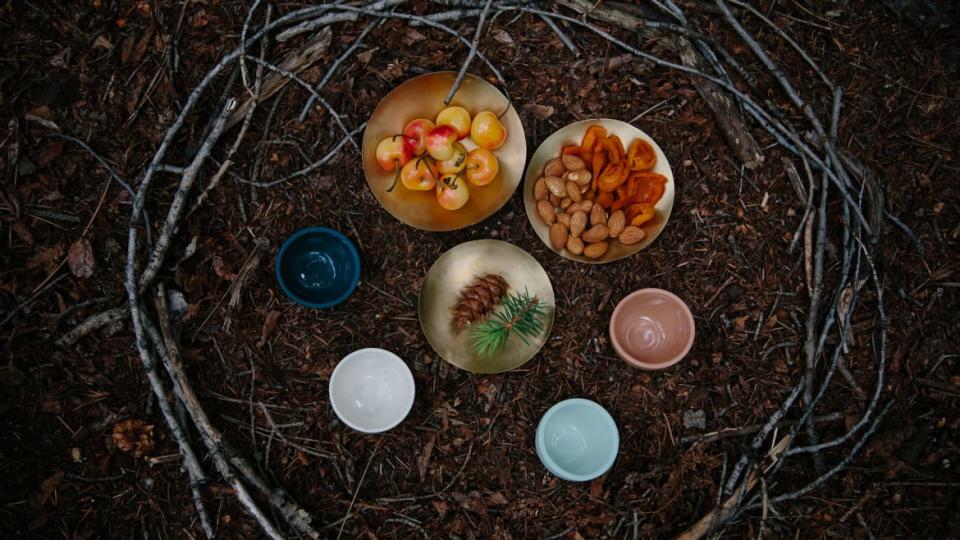Forget Weed. Colorado's Hottest Trend is Forest Bathing.

If you’re like me, maybe you’re thinking: ‘Forest bathing? Sounds like a bunch of hippies skinny-dipping in the woods.’
Wrong. Contrary to my own initial reaction, forest bathing has nothing to do with bathing and it doesn’t even have to take place in a forest. Rather, the Japanese practice of Shinrin-Yoku, which translates to "forest bathing" or "taking in the forest atmosphere,” emphasizes the importance of slowing down to connect with nature. It was developed in Japan during the 1980s and has become a cornerstone of preventive health care and healing in modern Japanese medicine.
My first “forest bath” was in Colorado, a much slower (and less exhausting) alternative to the hiking, mountain biking, and skiing the region is best known for. The practice has gotten so popular in the Rocky Mountain state that guides are available in half a dozen cities and a forest therapy guide training program in Colorado this September filled up many months in advance. Forest bathing is growing in popularity around the world and guides can even be found in major metropolitan cities like London and New York City. That said, the blue spruce, Ponderosa pine, white fir, quaking aspen, and other stunning and aromatic trees native to Colorado make it an excellent place to get your nature bath on.
According to the Association of Nature and Forest Therapy (yes, “forest therapy” is actually a thing), forest therapy is a “research-based framework for supporting healing and wellness through immersion in forests and other natural environments.” Studies have demonstrated a wide array of health benefits associated with spending time in nature, from lowering cortisol concentrations and blood pressure to improving mood and cognition. Many doctors are even writing “nature prescriptions”, instructing patients to begin spending more time outdoors. Last year, the National Park Service launched a five-year Healthy Parks Healthy People strategic plan to promote parks as health resources that will contribute positively to people’s physical, mental, and spiritual health.
Leona Campbell, the owner of Wind in Pines forest therapy, met me at a picnic table in Reynolds Park, a large public park about an hour southwest of Denver. I was joined by Jill Brown, a Midwest transplant who is now a manager at the Denver Animal Shelter. We walked far enough into the park that the parking lot was out of sight, but close enough that we could escape to our cars should the light drizzle turn into a downpour. In order to avoid potential distractions, I decided to leave my phone and notebook in the car. Looking back, I know that it would have been impossible to truly experience the impact of forest bathing had I attempted to document the process.
A quick note about forest therapy guides—they’re not guides in the traditional sense, in that they’re not identifying trees or sharing historical facts. Rather, forest therapy guides lead participants on a quiet walk through nature, drawing them out of their heads and into their senses by inviting them to see, hear, feel, and even taste what is around them. One person may lean against a tree and smell the bark of a Ponderosa pine (which I discovered can smell like butterscotch) while someone else may splash in a stream, meaning each person has a different experience.

We were invited to close our eyes and tune into each of our senses individually—the sense of the space, the scents, the sounds, the feel, and even the taste of the woods (I struggled with this last one a bit). We were invited to slowly turn and notice how our senses may differ in each direction, settling on the direction we felt most drawn to. Ms. Campbell invited us to “track a particular scent until you lose it, then pick up another scent and track it.”
The word “invitation” is key because participants are given only invitations, or suggestions, not explicit instructions. They are encouraged to explore any sense or experience they feel especially drawn to. I grew bored with an invitation to identify “tastes” in the woods (truthfully, I just found it too difficult so I abandoned it), so I hopped from rock to rock to cross a stream and climbed on top of a fallen cottonwood tree. I ran my fingers along the rough bark and the slippery green moss that covered most of the trunk. A small yellow butterfly joined me on the cottonwood, providing a pop of color to the mostly brown and green landscape.
As calm and relaxed as I felt in the woods, I still struggled to quiet my mind. Instead of observing my surroundings and enjoying the peacefulness, I tended to over-analyze my reactions and turn experiences into metaphors for life in general. During an invitation to focus on the various sounds around us, my attention immediately went to the most dominant sounds, the water babbling in the spring and the rain drizzling onto the ground. Were the dominant sounds low hanging fruit in the world of sounds? Was this a metaphor for my laziness?
Eventually, I started to be able to distinguish the tiny splashes of singular rain drops onto each delicate leaf, all weaving into the greater song of Mother Nature. I looked down and saw tiny ants scurrying to and from an ant hill as they carried bits of leaves and branches. “Nature” was no longer just a pretty backdrop and I became more aware of the individuals that are collectively known as “nature”.
It was almost as though I was experiencing nature with the same wonder that I had as a child, and have long since lost. As adults, we often don’t give ourselves the space to sit and enjoy nature, and forest bathing creates the space for people to have these experiences, which can also be influenced by our personalities.

A particularly memorable invitation was to approach a stream, and to slowly lower our hands to the water. We were first instructed (“invited”, actually) to hover our hands about a foot above the water, then a few inches above the water, then to dip only our finger tips into the water, and finally to fully submerge our hands into the stream. We were then invited to engage with the water in “whichever way we felt drawn”.
For me, this invitation was an exercise in self-control. This was likely the slowest activity I’d ever done in my life—there was zero pressure to rush, zero pressure to follow directions, and the guide made it clear we could explore any sense or activity we felt drawn to—yet I found it extremely difficult to hover my fingertips a few inches above the water. I wanted to immediately plunge my hands into the water and I even got a bit annoyed that it was taking the guide so long to invite us to fully submerge our hands. Perhaps this was the New Yorker in me—there I go analyzing again! I found relief “engaging with the water” by picking up rocks and throwing them to different parts of the stream.
Ms. Brown, who joined me in the experience, also tended toward metaphorical explanations and had an emotional reaction to the water invitation. The stream reminded her of one that she used to play in as a child, which then reminded her of her parents, who now live so far away. She used her hands and rocks to build a small dam in the stream. ”This small thing (dam) can make such a big impact on the stream. Basically, that’s life.” I suspect that Ms. Brown, a runner, would not have drawn such conclusions during a run along the same stream.
As water flowed through my fingers in the stream, I recalled a passage I read years ago by the prominent spiritual teacher, Eckhart Tolle, who encourages mindfulness in such simple activities as hand washing. Essentially, one can choose to focus on the temperature of the water or the sensation of the soap suds instead of worrying about what to make for dinner or whether a recent social media post got enough likes.
Forest bathing is more of an embodied experience than a mindful one but the practice is somewhat similar to a moving meditation. As someone who struggles with meditation—no in-person workshop or phone app has been able to get me to sit still—I found forest bathing to be a more practical way to stay present. By focusing on the rough texture of the maple leaf, the smell of the Douglas fir, the sound of the hummingbird, and the coolness of the water, I finally found myself present.
For those of us who don’t live near a forest, know that heavily wooded areas aren’t required to enjoy the benefits of forest bathing. Head to a local park, a nearby trail, your favorite beach, a lake, a river, or just about any natural environment. Step outside during your lunch break to notice the scents and sounds—just be sure to silence your phone! Simply be present and bathe your senses in nature.
Get our top stories in your inbox every day. Sign up now!
Daily Beast Membership: Beast Inside goes deeper on the stories that matter to you. Learn more.

 Yahoo News
Yahoo News 
